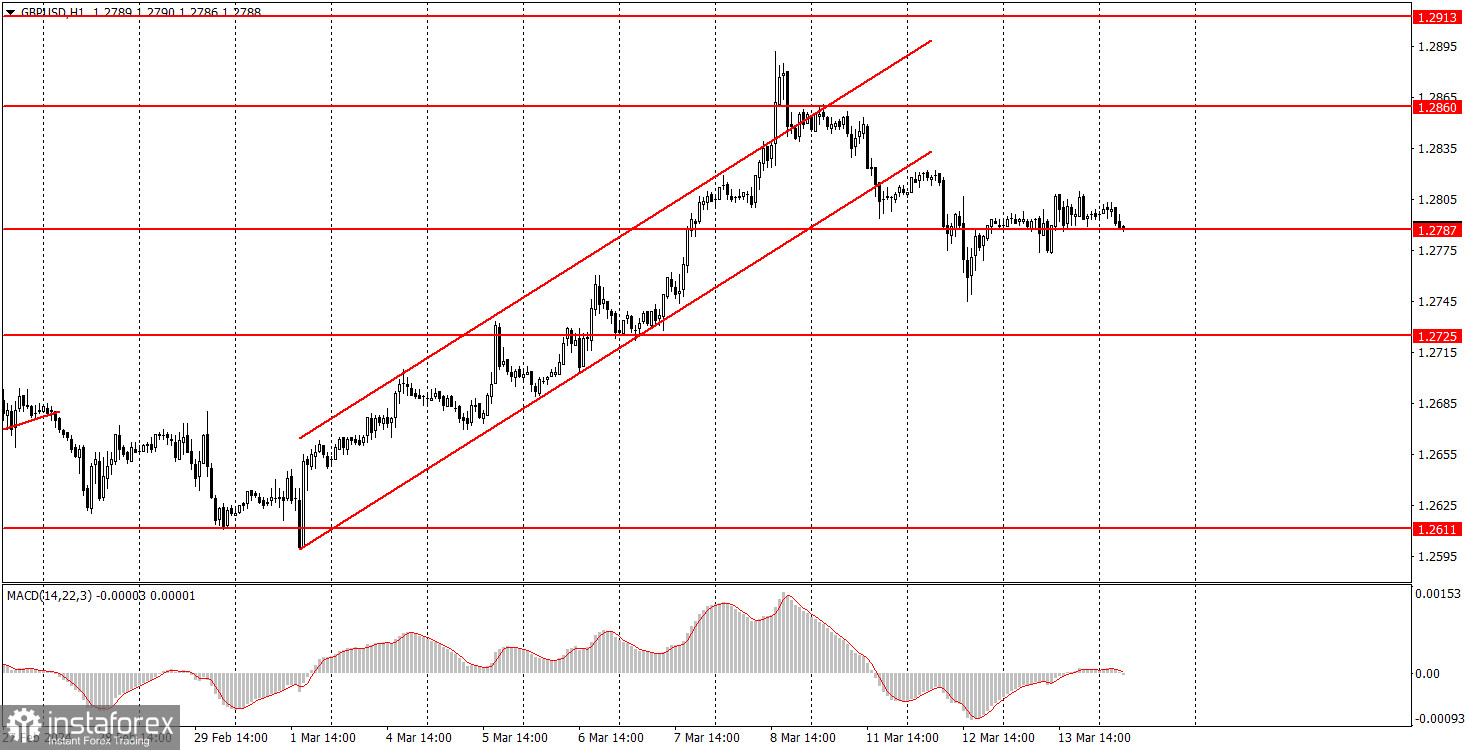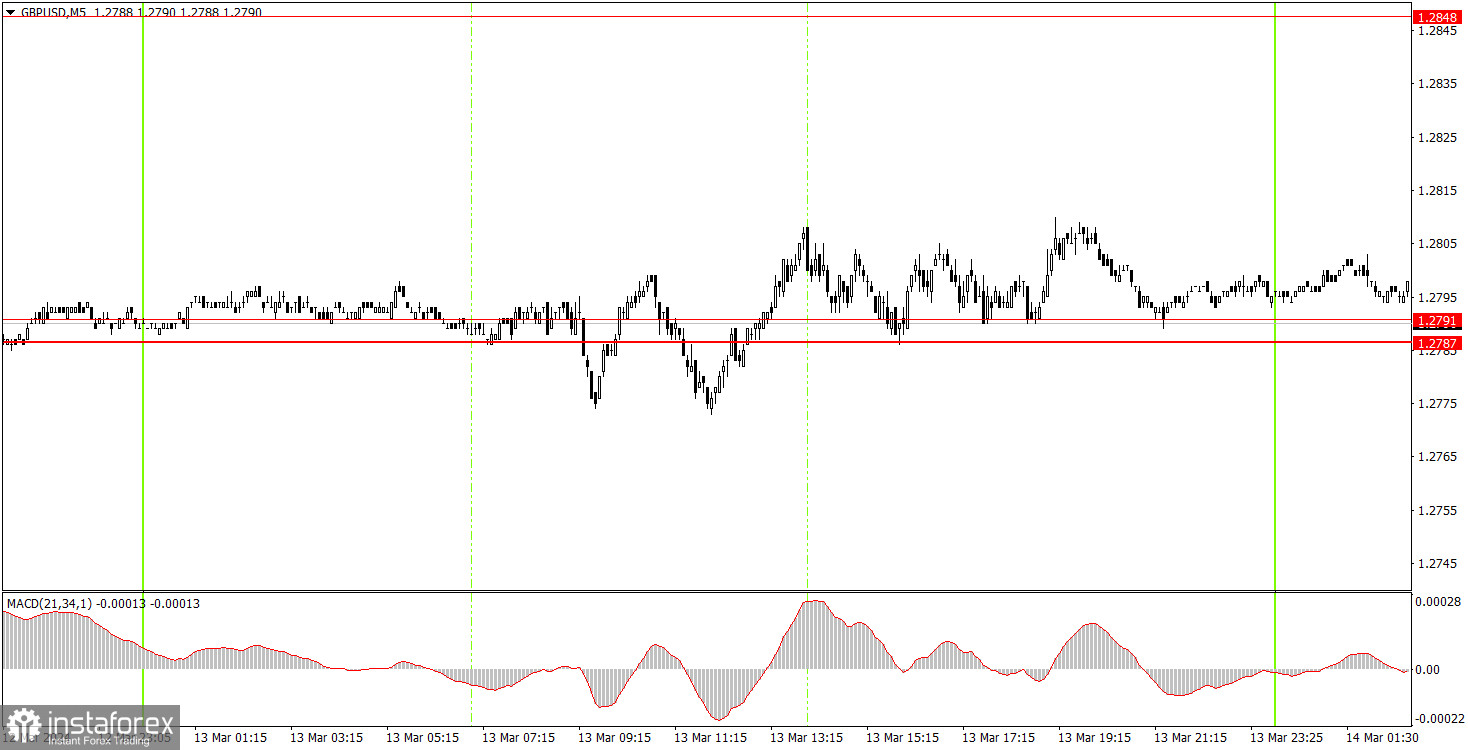Analyzing Wednesday's trades:
GBP/USD on 1H chart

GBP/USD traded in an illogical manner on Wednesday. The UK released two reports that could have influenced the pair's movement in some way, but the market had a minor reaction to them. GDP grew by 0.2% in January, in line with traders' expectations, but industrial production decreased by 0.2%, which was below forecasts. Therefore, the pound was supposed to fall yesterday. However, not only did we witness low volatility but also a complete absence of any kind of trend. After the pair left the ascending channel, the pair had a reason to fall further. However, take note that the market is reluctant to buy the dollar at the moment.
The situation doesn't look great. The pound was in a total flat for three months, then it suddenly increased without any logical reason behind it, and now it doesn't know what to do next. Volatility is low and there are a lot of reasons for the pound to fall rather than show growth.
GBP/USD on 5M chart

The pair was moving sideways on the 5-minute timeframe. Unfortunately, levels 1.2787 and 1.2791 were present within the trading range, so the price only managed to exceed them four times during the day. In addition, there were four rebounds from the specified area. Naturally, in a flat state, all these signals turned out to be false signals, so we didn't even bother to highlight them. Once again, we remind you that it is difficult to expect good profit when volatility is weak and there is no trend.
Trading tips on Thursday:
On the hourly chart, GBP/USD intends to resume the upward trend, although there are no fundamental and macroeconomic grounds for the pound to rise. The pair has consolidated below the ascending channel, but this does not guarantee that the pound will continue to fall. The market is focused on buying, and it doesn't need any corresponding data to buy the pound.
The key levels on the 5M chart are 1.2372-1.2387, 1.2457, 1.2502, 1.2544, 1.2605-1.2611, 1.2648, 1.2691, 1.2725, 1.2787-1.2791, 1.2848-1.2860, 1.2913, 1.2981-1.2993. On Thursday, there are no important events planned in the UK. The US docket will feature reports on retail sales, initial jobless claims, and the Producer Price Index. We do not expect a strong market reaction to this data, and we certainly do not expect the dollar to receive support from these reports.
Basic trading rules:
1) Signal strength is determined by the time taken for its formation (either a bounce or level breach). A shorter formation time indicates a stronger signal.
2) If two or more trades around a certain level are initiated based on false signals, subsequent signals from that level should be disregarded.
3) In a flat market, any currency pair can produce multiple false signals or none at all. In any case, the flat trend is not the best condition for trading.
4) Trading activities are confined between the onset of the European session and mid-way through the U.S. session, after which all open trades should be manually closed.
5) On the 30-minute timeframe, trades based on MACD signals are only advisable amidst substantial volatility and an established trend, confirmed either by a trendline or trend channel.
6) If two levels lie closely together (ranging from 5 to 15 pips apart), they should be considered as a support or resistance zone.
How to read charts:
Support and Resistance price levels can serve as targets when buying or selling. You can place Take Profit levels near them.
Red lines represent channels or trend lines, depicting the current market trend and indicating the preferable trading direction.
The MACD(14,22,3) indicator, encompassing both the histogram and signal line, acts as an auxiliary tool and can also be used as a signal source.
Significant speeches and reports (always noted in the news calendar) can profoundly influence the price dynamics. Hence, trading during their release calls for heightened caution. It may be reasonable to exit the market to prevent abrupt price reversals against the prevailing trend.
Beginners should always remember that not every trade will yield profit. Establishing a clear strategy coupled with sound money management is the cornerstone of sustained trading success.





















